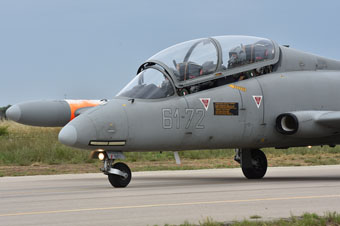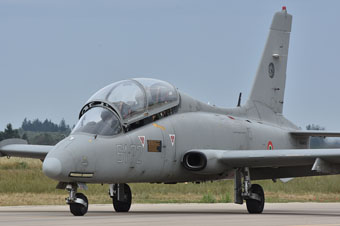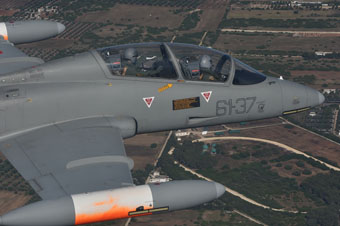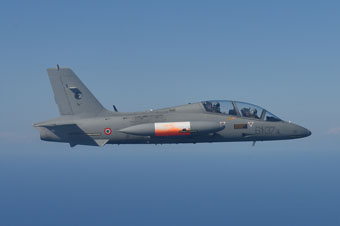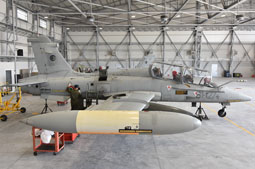 |
|
Organizzazione
Il 61° Stormo è intitolato alla MOVM (Medaglia d’Oro al Valor Militare) Sottotenente A.A.r.n. Pilota Carlo Negri, nato a Genova il 26 settembre del 1919. Nonostante la chiamata alle armi nel 1939, viene ammesso in ritardo al servizio militare in quanto iscritto al 4° anno di ingegneria industriale all’Università di Milano. Di sua volontà invece, nel pieno svolgimento della Seconda guerra mondiale (22 luglio 1941), interrompe gli studi per arruolarsi in Aeronautica. Già in possesso del Brevetto di Pilota Civile viene inviato presso il Centro Istruzione Reclute di Orvieto dove è nominato Primo Aviere Ufficiale Pilota, cinque mesi dopo transita invece alla Scuola di Pilotaggio di Pistoia e il 15 ottobre del 1942, ottiene il Brevetto di Pilota d’Aeroplano su Ro.41.
Il 7 novembre è trasferito invece alla Scuola di Pilotaggio di 2° Periodo di Castiglion del Lago dove ottiene la promozione a Sergente, successivamente è la volta del passaggio alla Scuola di Pilotaggio di Gorizia.
Gli eventi dell’8 settembre del 1943 lo sorprendono in quel di Gioia del Colle, dove era dislocato con il suo Reparto, all’indomani gli viene ordinato dal suo Comandante di spostarsi sul campo di Galatina, da dove intraprende una serie di missioni tra cui quella che gli risulta fatale. Il 21 settembre si offre ancora una volta volontario per una missione particolarmente rischiosa a bordo del suo Macchi MC.200, lanciare un messaggio agli italiani accampati nei pressi del campo sotto assedio dei tedeschi, lo scopo della missione era quella di stabilire un collegamento che consentisse di inviare dei soccorsi.
Invano Negri effettua alcuni passaggi nel tentativo di scorgere i commilitoni, nonostante il fuoco nemico si abbassa ulteriormente e qui viene colpito dalla contraerea nemica, con il velivolo danneggiato invece di allontanarsi decide di atterrare per consegnare di persona il messaggio ad un soldato italiano accorso nei pressi, purtroppo per lui sopraggiungono anche dei soldati tedeschi che lo catturano, due giorni dopo viene barbaramente fucilato. Per il gesto eroico gli è stata concessa la Medaglia d’Oro, la prima attribuita a personale dell’Aeronautica coinvolto nella Guerra di Liberazione. L’intitolazione dello Stormo al Sottotenente avviene invece nel 2003.
Il 61° Stormo dipende dal Comando Scuole AM/3ª Regione Aerea con sede a Bari, ha il compito di provvedere all'addestramento al volo su aviogetti:
- di Fase II - Primary Pilot Training, comune a tutti gli allievi piloti militari, finalizzata alla individuazione delle linee su cui voleranno: aerotattiche, pilotaggio remoto RPA (Remotely Piloted Aircraft), elicotteri, convenzionali (trasporto), si svolge sul velivolo MB 339A (T-339A);
- di Fase III – Specialized Pilot Training, rivolta esclusivamente agli allievi piloti selezionati per le linee "aerotattiche" e "RPA", si conclude con il conseguimento del Brevetto di Pilota Militare (aquila turrita), per questa fase è impiegato l'MB 339CD (FT-339C);
- di Fase IV - Lead In to Fighter Training – LIFT, propedeutica al successivo impiego sui velivoli fast jet, si sviluppa sull’M 346 (T-346A).
Oltre che agli allievi piloti dell’Aeronautica Militare, la Scuola di Volo è aperta anche ad allievi piloti di altre Forze Armate, provenienti da nazioni con le quali l’Italia ha sottoscritto accordi di cooperazione.
Inoltre il 61° Stormo concorre con i propri assetti alle attività operative della Difesa secondo le modalità richieste.
Lo Stormo, strutturato secondo i più recenti standard di Forza Armata, ha tre Gruppi di Volo: il 212° Gruppo provvede alla formazione dei piloti nella cosiddetta Fase IV – LIFT; il 213° Gruppo provvede alla formazione dei piloti svolgendo la Fase III con il rilascio del Brevetto di Pilota Militare; il 214° Gruppo provvede allo svolgimento della Fase II Nazionale.
Ogni Gruppo Volo del 61° Stormo ha alle dipendenze quattro Squadriglie ed ogni Squadriglia è retta da un Comandante (un pilota istruttore di norma con il grado di Capitano), direttamente dipendente dal Comandante di Gruppo. Gli altri piloti istruttori del Gruppo sono suddivisi tra le quattro Squadriglie. Gli allievi piloti (per il 213° e per il 214° GV) e i frequentatori (per il 212° GV) vengono assegnati alle Squadriglie cercando di mantenere le diverse classi addestrative unite in un'unica Squadriglia e di fare in modo che vi sia una ripartizione equa, che tenga conto degli spazi e del carico di lavoro di ciascuna Squadriglia.
Sono parte integrante del Reparto anche l’Ufficio Operazioni, l’Ufficio Comando, il CAE (Centro Addestramento Equipaggi), il 961° Gruppo Efficienza Aeromobili, il Reparto Logistica, il Gruppo Protezione delle Forze (GPF), il Servizio Amministrativo e l’Infermeria di Corpo.
Co-ubicato con lo Stormo, insiste sul sedime di Galatina anche il 10° RMV (Reparto Manutenzione Velivoli) che si occupa delle manutenzioni di livello tecnico più complesso. Il 10° RMV fornisce supporto a tutta la flotta MB 339 della Forza Armata, inclusi i velivoli delle Frecce Tricolori, oltre alla manutenzione dell’M 346.
Inoltre il 61° Stormo svolge le funzioni di presidio Aeronautico e Circoscrizione Aeroportuale per le province di Lecce e Brindisi.
I criteri fondamentali della formazione degli equipaggi di volo sono aderenti ai programmi impartiti dal Comando delle Scuole AM/3ª Regione Aerea di Bari e si sviluppano nel rigoroso rispetto delle direttive impartite dallo Stato Maggiore.
Pur essendo a tutti gli effetti la Scuola in cui i piloti militari coronano il sogno di vedersi appuntare al petto l’ambita Aquila Turrita (simbolo del Pilota Militare), il 61° Stormo ha partecipato, con i propri equipaggi e velivoli, a numerose esercitazioni svolte sia in Italia che all’estero. Competenza, Passione e Innovazione Continua al Servizio del Paese: questa la vision della più importante scuola di volo italiana.
|
 |
|
Aeroporto
L’aeroporto di Lecce-Galatina è intitolato alla Medaglia d’Oro al Valor Militare Tenente Pilota Fortunato Cesari. Cesari è nato a Galatina il 17 marzo del 1912 mentre si arruola in Aeronautica come Allievo Ufficiale Pilota di Complemento il 4 marzo del 1933. La prima assegnazione è presso il 21° Stormo Caccia Terrestre. Nel 1934 cessato il servizio di prima nomina è collocato in congedo ma, appena un anno dopo è richiamato in servizio e inquadrato presso la Scuola Caccia. Il 16 giugno del 1935 è assegnato prima al 5° Stormo d’Assalto e poi il 2 agosto al 4° Stormo Caccia Terrestre. Il 25 gennaio del 1936 è inviato in Africa a disposizione dell’aeronautica dell’Africa Orientale italiana dove, durante la conquista dell’Impero etiopico partecipa a 38 azioni di guerra distinguendosi per doti di coraggio, per spirito di sacrifico e per le elevati doti combattive.
Durante un’azione di ricognizione a grande raggio è costretto ad atterrare presso il lago Auasa (Radama - Etiopia), nel tentativo di difendere il compagno osservatore gravemente ferito cade sotto i colpi dei ribelli.
La nascita del Campo di Fortuna di Lecce viene sancita con un Decreto dell’allora Ministro Italo Balbo il 31 marzo del 1931.
In un primo momento il Campo di Fortuna viene intitolato al Capitano Pilota Antonio Ramirez. Nel 1936 con la costruzione del Regio Aeroporto di Lecce (di seconda classe) viene cambiata l’intitolazione e designato come sede del 37° Stormo Bombardieri Terrestri dotato di velivoli S.81. Successivamente, oltre al 37° si aggiunge anche il 96° Gruppo Autonomo Bombardieri Terrestri, quest’ultimo dotato di Junkers JU 87. In questo frangente iniziano le operazioni contro la Grecia. Nel 1940 avviene un cambio di reparto, il 96° lascia il posto al 97° Gruppo proveniente da Trapani.
Per operare sul fronte greco-albanese a Lecce si alternano una moltitudine di reparti, cerco di elencarne alcuni: una sezione dell’87ª Squadriglia Osservazione Aerea con Caproni Ca.311, il 149° Gruppo Trasporti SAS, il 101° Gruppo Autonomo Bombardamento in Picchiata e la 209ª Squadriglia Autonoma Bombardamento in Picchiata su JU 87 “Stuka”, la 373ª e 374ª Squadriglie Autonome Caccia Terrestri con MC.200.
Nel marzo del 1941 una formazione inglese di Blenheim colpisce per la prima volta il campo di Lecce-Galatina, successivamente il 37° Stormo, ora dotato di velivoli Breda BR.20 cambia scenario ed interviene a favore dell’occupazione di Cefalonia e Corfù.
Cessate le ostilità nei Balcani, cessa anche la funzione di impiego bellico vero e proprio dell’aeroporto, la sua funzione principale in questo frangente è più rivolta ad un utilizzo come scalo di transito verso altri fronti della guerra.
Da questo momento sino alla fatidica data dell’8 settembre, che sancisce l’armistizio, su Lecce continuano ad alternarsi reparti italiani e tedeschi, per ragioni di spazio elenco solo quelli italiani: la 361ª Squadriglia Autonoma Caccia Terrestri, il 155° Gruppo Autonomo Caccia Terrestri con Fiat G.50, ancora il 147° Gruppo, una sezione del 56° Gruppo Bombardieri Terrestri con S.81, il 43° Stormo Bombardieri Terrestri con BR.20, il 45° Stormo Trasporti, il 50° Gruppo Bombardamento Terrestre su Cant Z.1007tris, la 162ª e 169ª Squadriglie Autonome Caccia Terrestri, il 3° Gruppo Autonomo Caccia Terrestri con MC.200, una Squadriglia Caccia Notturna con CR.42, il 2° Gruppo Autonomo Caccia Terrestri con Reggiane RE.2001, il 38° Gruppo Autonomo da Bombardamento su S.84, il 1° Nucleo Addestramento Bombardieri con SM.84 e Cant Z.1007.
Poco prima dell’armistizio l’aeroporto di Lecce viene bombardato pesantemente da uno reparto di B 24 “Liberator” della 9th Air Force dell’USAAF (United States Army Air Force).
La rinascita dell’aeroporto di Lecce avviene dopo l’armistizio quando sul campo ormai devastato si avvicendano tutti i reparti della nascente Aeronautica Militare, nonché alcuni reparti della Royal Air Force dotati di Bristol Beufighter e dell’USAAF con velivoli P 38 e B 24, per quanto riguarda i reparti italiani nel periodo 1943 – 1947 vengono costituite due grandi unità operative nazionali, il Raggruppamento Caccia e il Raggruppamento Bombardamento e Trasporti, non si può non citare che in questo periodo hanno operato a Lecce reparti come il 4° Stormo, il 5° Stormo e il 51° Stormo, il 2° Gruppo e il 98° Gruppo dello Stormo Trasporti.
|
 |
 |
 |
 |
|
Integrated Pilot Training System 2020
L’IPTS 2020 è l’ultimo dei sistemi addestrativi adottati dal Comando Scuole dell’Aeronautica Militare, la sua entrata in vigore risale al gennaio del 2014 ed il primo corso accademico a favorirne è stato il Marte V.
Nel campo dell’addestramento i cambiamenti più importanti degli ultimi decenni sono stati sicuramente quelli che hanno visto l’arrivo degli addestratori a reazione, prima con l’MB 326 che ha visto per un breve periodo l’applicazione anche di un percorso formativo denominato “jet ab-initio”, e successivamente anche con l’MB 339.
Un'altra svolta importante si è verificata nel periodo a cavallo tra il 2004 e il 2005 quando si è abbandonata la designazione “addestramento di 1°/2°/3° Periodo di Volo”, terminologia utilizzata sin dagli albori dell’aviazione militare in Italia, a favore di quella attuale chiamata “Fase I-II-III e IV”. Premesso che la “Fase I” è sempre stata svolta su velivoli ad elica monomotori, al netto del breve periodo del “jet ab-initio” citato prima, la “Fase II” ha visto l’impiego quale addestratore l’MB 339A e per certo un periodo di tempo, dal 2006 anche del velivolo SF 260EA, in virtù delle migliori performance rispetto alla precedente versione SF 260AM. L’ultimo corso per il conseguimento del Brevetto di Pilota Militare (BPM), caratterizzato da un percorso addestrativo comune a tutti i piloti militari, svolto dal 213° Gruppo con l’MB 339CD, è terminato il 9 aprile del 2015.
Negli anni molte sono state le varianti ai percorsi formativi/addestrativi, dovute a cause di forza maggiore. Si cita ad esempio la momentanea messa a terra dell’SF 260EA nell’estate del 2013. Per tale motivo, il corso Leone V ha dovuto proseguire la Fase II a Galatina sull’MB 339A, riportando le lancette del tempo a prima del 2006, quando l’SF 260EA non era ancora stato immesso in servizio.
Con l’attivazione dell’IPTS 2020 si è dato avvio al cosiddetto iter addestrativo differenziato, con una Fase III specialistica proiettata sulla linea di impiego finale, e si è abbandonato l’iter unico su aviogetto.
L’addestramento svolto a Lecce-Galatina per un pilota militare riveste una notevole importanza, inferiore solo al momento in cui il pilota spicca il primo volo da solista e consegue il BPA (Brevetto di Pilota d’Aeroplano).
Durante la Fase II gli istruttori del 61° Stormo hanno l’arduo compito di formare, valutare e selezionare gli allievi in base al loro rendimento e alle loro attitudini al volo, e di conseguenza indirizzarli verso la linea di volo più adeguata, che può essere: Elicotteri, Convenzionali, Remoti ed Aerotattica. I piloti assegnati alla “Fase III Aerotattica e Remoti” restano a Galatina, per gli altri avviene il trasferimento al 72° Stormo di Frosinone (Linea Elicotteri) o al Centro Addestramento Equipaggi-Multi Crew (CAE-MC) di Pratica di Mare o alla Rappresentanza Aeronautica Militare italiana (RAMi) di Avord - Francia (Linea Convenzionali) dove conseguono il BPM sulla specifica linea di impiego.
Per i piloti assegnati alla linea caccia l’addestramento riveste un attenzione ed un organizzazione particolare.
Attualmente la linea da combattimento dell’Aeronautica è incentrata su cacciabombardieri Tornado ed AMX e da caccia multiruolo F 2000 Typhoon e F 35 Lightning II. Come da programma, nel corso dei prossimi anni i primi due velivoli verranno ritirati dal servizio e quindi rimarranno attivi solo i due caccia multiruolo.
Se negli anni passati si addestravano piloti con un ruolo specifico in base alla linea di assegnazione, intercettori o attacco al suolo, la sfida di questi ultimi anni è quella di preparare piloti multiruolo – swing role che sappiamo svolgere indistintamente i ruoli: aria-aria, aria-suolo, ricognizione o sorveglianza elettronica, fino ad arrivare al più recente concetto Omni-Role introdotto con l’avvento degli aeromobili di 5ª generazione. Ovviamente questa preparazione avviene in un periodo che si protrae ben oltre l’addestramento svolto presso il 61° Stormo. In questo contesto bisogna considerare che l’ora di volo di un caccia di 4ª/5ª generazione, come l’F 2000 o l’F 35, è molto dispendiosa, l’Aeronautica Militare ha voluto introdurre questo nuovo sistema addestrativo che tiene conto anche dei costi/benefici di un addestramento differenziato, questo ragionamento si è reso possibile anche con l’arrivo del nuovo addestratore M 346 Master, trovando così un ottima soluzione che tiene conto appunto dei costi di far addestrare un pilota su di un caccia di 4ª o 5ª generazione a ragione del beneficio di farlo volare su di un addestratore con un minore costo per ora di volo, ma che garantisce una adeguata preparazione alla successiva fase di conversione operativa.
L’addestramento a Galatina è suddiviso nelle Fasi II, III e IV, ricordo che la Fase I che porta al conseguimento del BPA viene svolta al 70° Stormo di Latina sull’SF 260EA.
Prima di iniziare l’addestramento al volo gli allievi vengono assegnati al CAE (Centro Addestramento Equipaggi) del 214° Gruppo, che si occupa della loro preparazione teorica, e dove rimangono per circa un mese, mantenendoli comunque in carico amministrativo fino al completamento dell’iter addestrativo. Il CAE è stato istituito nel gennaio del 2017 ed è formato da istruttori piloti e da ufficiali del Ruolo delle Armi, i piloti istruttori del CAE svolgono anche loro le normali attività addestrative di volo.
|
|
|
|
|
La Fase II, oltre a quella svolta a Galatina, può essere effettuata anche presso le RAMi di Kalamata (Grecia) o di Sheppard AFB (Stati Uniti), entrambe su velivolo T-6A Texan II.
Lo svolgimento della Fase II Nazionale è in carico al 214° Gruppo sul velivolo MB 339A, la durata totale è di sette mesi, di cui 25 giorni per la Ground School, 75 sono le missioni di volo che vengono svolte per una durata minima di ore volo pari a 88 ore e 25 minuti, o per un massimo di 100 ore. Le missioni al simulatore sono in totale 37 per 45 ore di volo.
In questo fase l’allievo deve acquisire una sempre maggiore confidenza con il velivolo, le missioni vengono svolte tutte con il volo a vista (contact), e comprendono l’acrobazia e pratica di atterraggi. Il passaggio successivo prevede il volo strumentale basico, dove si insegna la condotta del volo mediante l’utilizzo degli strumenti di bordo, per abituarli al volo in condizioni meteorologiche avverse, gli avvicinamenti radio-assistiti per l’atterraggio, la navigazione strumentale in aerovia, 16 missioni di volo in formazione a due “in ala”, e sette missioni di volo a bassa quota (1.000 piedi).
Al termine della Fase II gli allievi piloti destinati alla linea aerotattica vengono di nuovo mandati al CAE per fare un ulteriore mese di Ground School, propedeutica alla successiva immissione nella Fase III Fighter Track. Da questo momento al CAE vengono assegnati anche gli allievi che hanno svolto la Fase II all’estero.
La Fase III “Linea Caccia” viene svolta dal 213° Gruppo Volo con i velivoli MB 339CD, in base alla provenienza degli allievi, essi svolgeranno due iter addestrativi differenziati, questo perché è necessario integrare ed uniformare l’addestramento ricevuto dalle varie scuole, tenendo conto che i piloti provenienti da Kalamata e Sheppard si sono addestrati su velivoli a turboelica, in contesti aeronautici diversi da quello nazionale.
La Fase III per i piloti che hanno svolto la Fase II Nazionale ha una durata complessiva di otto mesi e mezzo, la Ground School dura dai 15 ai 20 giorni, vengono svolte 78 missioni per un minimo di 90 ore e mezza di volo o per un massimo di 106 ore di volo. La simulazione prevede 30 missioni per poco più di 40 ore di volo sintetiche.
Se invece la Fase II è stata svolta all’estero la durata del corso aumenta a nove mesi, di cui 30 giorni di Ground School, 92 missioni di volo per 118 ore di volo, 38 missioni al simulatore per 48 ore e 20 minuti di volo sintetico.
Il programma addestrativo della Fase III è molto simile all’iter precedente, vengono ampliate quelle forme di volo a vista e strumentali già svolte nella Fase II, il volo in formazione viene ampliato fino ad un massimo di quattro velivoli, ma soprattutto vengono implementate quelle missioni tipiche del pilota militare della linea caccia, come il volo a bassa quota, le missioni in poligono aria-suolo con tecniche di tiro con il cannone e di bombardamento, l’addestramento al rifornimento in volo, e si cominciano ad effettuare le prime missioni di combattimento aereo con le manovre BFM (Basic Fighter Maneuvers). |
|
|
|
|
La Fase III “APR- Aeromobili Pilotaggio Remoto”
Questa fase addestrativa dell’IPTS 2020 è iniziata solo nel maggio del 2016, nel periodo antecedente i piloti assegnati ai cosiddetti “droni” venivano trasferiti temporaneamente dai reparti operativi della Linea Aerotattica.
L’addestramento di Fase III “Linea APR” viene svolta sempre dal 213° Gruppo con l’MB 339CD, se il pilota proviene dalla Fase II Nazionale svolgerà 48 missioni di volo per terminare l’iter, se proviene dalla Fase II Estera ne svolgerà sei in più. L’addestramento vero e proprio sulla condotta degli APR avverrà in un secondo tempo al reparto di assegnazione, per i piloti neo-brevettati destinati al Predator A la formazione finale sarà presso il 32° Stormo di Amendola (Foggia), se invece il velivolo assegnato sarà il Predator B, l’addestramento verrà svolto presso un reparto addestrativo dell’USAF (United States Air Force) nel Nuovo Messico o nel Nevada.
Al completamento della Fase III gli allievi diventano piloti militari e gli viene assegnato il BPM (Brevetto di Pilota Militare), e la tanto desiderata Aquila Turrita, simbolo distintivo del Pilota Militare.
La Fase IV viene svolta dal 212° Gruppo, reparto dotato appunto del velivolo di produzione nazionale Leonardo M 346 Master. Come scritto precedentemente il velivolo garantisce un addestramento pre-operativo superiore rispetto ai precedenti velivoli utilizzati, l’MB 339CD in Italia o il T 38A negli Stati Uniti, e permette di diminuire le ore di volo che un pilota dovrà poi svolgere al successivo passaggio presso l’OCU (Operational Conversion Unit) di assegnazione.
La Fase IV ha una durata di circa nove mesi, di cui 20 giorni frequentando la Ground School, le missioni di volo sono 79 per 89 ore di volo, le missioni al simulatore in questa fase sono pari alle ore di volo reali, 96 missioni per 89,40 ore di volo sintetiche, tenendo conto che le ore di volo al simulatore sono equiparate all’ora di volo reale si ha un beneficio notevole sui costi per addestrare un pilota.
L’addestramento di Fase IV prevede un approfondimento delle attività svolte con la fase precedente, sia nell’effettuazione reale delle missioni che quelle simulate, basata sulle quattro forme fondamentali del volo, l’incremento avviene sia nel settore aria-aria che aria-suolo. Nel primo vengono svolte attività di combattimento aereo nel corto raggio (WVR – Within Visual Range) e nel lungo raggio (BVR – Beyond Visual Range), combattimenti aerei manovrati (dogfight) e vengono insegnate le tecniche per l’utilizzo del radar nelle intercettazioni, In questa fase i combattimenti sono 1v1 (uno contro uno) o 2v1 (due contro uno) e 2v2 (due contro due). Nel settore aria-suolo viene ampliato l’addestramento in poligono. Le pianificazioni e i contenuti delle missioni addestrative vengono sviluppate e armonizzate con le tattiche in uso presso i reparti di conversione operativa. Questo garantisce uno standard comune, aggiornato alle continue innovazioni introdotte nel campo dell’impiego aerotattico, e soprattutto assicura continuità tra le varie fasi addestrative. |
|
|
|
|
Il 61° Stormo è il reparto dove più risalta l’internazionalizzazione delle Scuole AM, soprattutto per la presenza di piloti istruttori provenienti da Austria, Argentina, Francia e Stati Uniti attualmente, in passato anche dalla Spagna.
Per quanto riguarda l’addestramento di Fase IV rivolta a frequentatori stranieri l’iter addestrativo viene modulato in base alle esigenze della Forza Aerea richiedente. |
 |
|
Simulatori
Il mondo della simulazione del volo finalizzata all’addestramento trova però al 61° Stormo il punto di eccellenza tecnologica nei sistemi integrati dedicati al velivolo M 346 Master, progettati e realizzati da Leonardo in parallelo al velivolo e in grado di integrarsi con le diverse fasi in volo. In sostanza si tratta di un ambiente di simulazione integrato in cui i piloti che volano sui simulatori possono interagire con altri piloti che, in quello stesso momento, sono su un aereo in volo reale, come se tutti stessero operando nello stesso contesto. Il sistema integrato di simulazione può offrire una vasta gamma di scenari grazie alla sua flessibilità di configurazione e, pertanto, può essere impiegato in tutte le fasi della formazione, permettendo ai piloti di addestrarsi nelle differenti tipologie di missione, dalle basiche alle più complesse, distribuendo le informazioni tramite data link con la stazione a terra e con altri velivoli M 346. Insomma un mix tra reale e virtuale in cui l’unico limite è rappresentato dalla fantasia umana.
|
 |
|
|
| I simulatori del velivolo MB 339 sono stati consegnati al 61° Stormo in momenti diversi tra il 2006 e il 2018. Forniti da ditte israeliane, sono gestiti dall’Aeronautica Militare in collaborazione con “Leonardo Divisione Velivoli” e la ditta costruttrice. I simulatori in carico alla scuola di volo di Galatina sono in totale quattro, due per la versione “Alpha” e due per la versione “Charlie/Delta”. La struttura di tutti i simulatori replica esattamente la cabina anteriore del velivolo, all’interno della quale è riprodotta fedelmente la strumentazione di bordo. Essi sono dotati di un sistema di proiezione di immagini ad alta qualità costituito da un DOM sferico con apertura orizzontale di 180° e verticale di 40° nella versione “Alpha” e di 90° in quella “Charlie/Delta”. Per entrambe le versioni è prevista una consolle esterna in cui l’istruttore è in grado di controllare ogni parametro del volo, riprodurre ogni condizione di volo possibile e simulare qualsiasi tipo di avaria e ogni condizione meteorologica. |
|
|
 Tra la fine del 1945 e l’inizio del 1946, il 2° Gruppo Volo della Scuola di Pilotaggio, con la dipendente 3ª Squadriglia, dotata di CR.42, viene trasferito da Lecce sull’aeroporto di Brindisi per svolgere il cosiddetto 2° Periodo di volo, poco dopo il Reparto assume la nuova denominazione di 212° Gruppo Volo e gli vengono assegnate la 402ª e la 403ª Squadriglia. Tra la fine del 1945 e l’inizio del 1946, il 2° Gruppo Volo della Scuola di Pilotaggio, con la dipendente 3ª Squadriglia, dotata di CR.42, viene trasferito da Lecce sull’aeroporto di Brindisi per svolgere il cosiddetto 2° Periodo di volo, poco dopo il Reparto assume la nuova denominazione di 212° Gruppo Volo e gli vengono assegnate la 402ª e la 403ª Squadriglia.
Nel settembre del 1954 rientra sull’aeroporto di Lecce dove continua ad operare come Scuola Volo di 1° e 2° Periodo, la dotazione prevede aerei di costruzione nazionale come i Fiat G.46 e americana come i T 6 “Texan”.
Dal 25 ottobre 1960 al 15 febbraio 1962 il 212° Gruppo addestra i piloti della Scuola Volo Periodo Basico Iniziale utilizzando solo i “Texan”. Dal 15 gennaio 1962 il Gruppo inizia la transizione sui nuovi velivoli a reazione Aermacchi MB 326.
Durante il 1982 il Gruppo inizia la conversione sul velivolo MB 339A con il quale continua l’addestramento basico iniziale (fino al 1990), e successivamente anche l’addestramento finale per il conseguimento del BPM (Brevetto di Pilota Militare) e di conseguenza l’ambita “Aquila Turrita.
Il 18 agosto 1995 il 212° Gruppo inizia il suo primo corso pre-operativo, ereditato con la chiusura pochi giorni prima del 204° Gruppo Addestramento Avanzato del 32° Stormo di Amendola. Nel settembre del 1997 il 212° Gruppo che, intanto è transitato sull’MB 339CD (Completamente Digitale), completa l’iter istruzionale dell’ultimo corso BPM assegnato al Gruppo.
Alla fine del 1998 il 212° Gruppo è pienamente operativo sul nuovo addestratore, unico Gruppo di Volo ad utilizzarlo in ambito di Forza Armata, da questo momento è deputato alla formazione pre-operativa (o Fase IV) del personale navigante (piloti e navigatori) dell’Aeronautica Militare destinato alla Linea Caccia. In aggiunta svolge un importante ruolo operativo in ambito Difesa Aerea, denominato SMI (Slow Mover Interceptor), che lo vede addestrato e pronto a contrastare velivoli che sfruttano la capacità di operare a velocità particolarmente basse e spesso in prossimità del terreno per sfuggire al controllo dei radar di terra e a quello degli intercettori pilotati. Ruolo che si è reso necessario dopo la rivalutazione delle possibili minacce seguite all’attentato dell’11 settembre 2001 a New York, evento che ha inevitabilmente evidenziato la necessità di creare sistemi efficaci e procedure efficienti in grado di contrastare possibili minacce terroristiche portate da mezzi aerei non necessariamente convenzionali.
Il 26 febbraio del 2015 il 212° Gruppo riceve il primo M 346 (MM55154) con cui svolge la Fase IV Linea Aerotattica – Fighter Track nell’ormai consolidato sistema addestrativo denominato IPTS 2020. Di conseguenza gli MB 339CD vengono “versati” al 213° Gruppo.
Con l’M 346 il 212° non effettua più il ruolo di SMI, che viene demandato ad altri reparti, ma in compenso acquisisce il ruolo di Aggressor (Simulazione di velivoli nemici nei combattimenti aerei), unico reparto di Forza Armata a svolgerlo.
Il 212° svolge anche il ruolo di GIP (Gruppo Istruzione Professionale), per i piloti istruttori assegnati al reparto.
Attualmente il 212° Gruppo è composto da quattro Squadriglie, la 402ª, la 403ª, la 424ª (trasferita dal 214° Gruppo il 20/07/1976) e la 426ª, quest’ultima di recente costituzione (10/12/2015).
|
 |
|
|
 |
 |
|
|
 |
 La storia del 213° Gruppo è legata agli eventi post armistizio dell’8 settembre 1943. Esso trae le sue origini dal 3° Gruppo, costituito il 30 novembre del 1945, successivamente al trasferimento della Scuola di Pilotaggio di Leverano a Lecce (1° Novembre 1945). La storia del 213° Gruppo è legata agli eventi post armistizio dell’8 settembre 1943. Esso trae le sue origini dal 3° Gruppo, costituito il 30 novembre del 1945, successivamente al trasferimento della Scuola di Pilotaggio di Leverano a Lecce (1° Novembre 1945).
Alle dipendenze del Reparto vengono assegnati la 5ª e la 6ª Squadriglia con il compito di svolgere l’Addestramento Basico Caccia e di 3° Periodo, ossia quello relativo all’ultima fase del conseguimento del Brevetto di Pilota Militare, mentre al 1° e 2° Gruppo, competono rispettivamente quello di 1° Periodo (Brevetto di Pilota d’Aeroplano) e di 2° Periodo (Addestramento Basico).
Il 3° Gruppo è dotato di velivoli Fiat G.8, Nardi Fn.305, Fiat G.50 “Freccia”, Macchi MC.200 “Saetta” e Saiman 200/202, questi ultimi utilizzati per il collegamento, successivamente vengono impiegati per l’Addestramento Caccia anche: MC.202 “Folgore”, MC.205 “Veltro”, Spitfire, Bell P 39 “Aira-Cobra”, Lockheed P 38 “Lightning I”, North American P 51 “Mustang” (dall’aprile 1949 al novembre 1958), North American T 6 “Texan”, Fiat G 59 (dall’aprile 1951 al novembre 1958), nonché i monomotori Macchi Ma.416, Macchi Bazzocchi MB 308 e Piaggio P 148 per il collegamento.
Il 1° Giugno 1954, il 3° Gruppo assume la nuova denominazione di 213° Gruppo e vengono poste alle sue dipendenze la 404ª e la 405ª Squadriglia, denominazione che rimarrà tale sino ai giorni nostri, analoga sorte spetta al 1° Gruppo, rinominato 211° Gruppo Autonomo ed al 2° Gruppo ora 212°.
Il 3° Gruppo, assieme al 2°, si occupa dell’Addestramento di 2° e 3° Periodo e dell’Addestramento Basico Caccia volando rispettivamente sui velivoli T 6, G.59 e P 51, mentre, per il collegamento vengono impiegati dei bimotori Beechcraft C 45 “Expeditor”.
Dal 20 luglio del 1976, a seguito della messa in posizione quadro del 214° Gruppo, la 425ª Squadriglia viene assegnata al 213° Gruppo dove resta fino ai giorni nostri.
Il 1° ottobre del 1981, dopo vent’anni di attività sul “326” e 400.000 ore di volo effettuate il 213° Gruppo effettua la transizione sul nuovo addestratore Aermacchi MB 339A. Con l’MB 339 “Alpha” il Gruppo svolge ininterrottamente dal 1982 al 2015 tutta l’attività addestrativa e istruzionale degli allievi (escludendo la parte iniziale svolta a Latina) fino al conseguimento del Brevetto di Pilota Militare.
Attualmente sono quattro le Squadriglie assegnate al 213° Gruppo Volo, la 404ª, la 405ª, la 421ª di recente costituzione (10/12/2015) e la 425ª.
|
 |
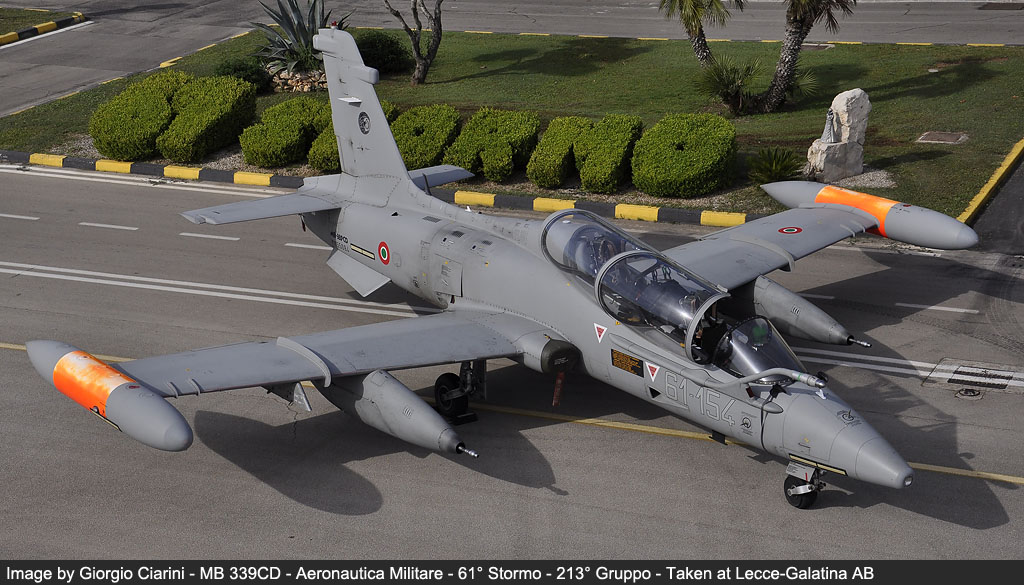 |
|
|
|
|
 Il 214° Gruppo Aviogetti è stato costituito presso la Scuola di Volo di Lecce il 1° gennaio del 1962, contestualmente gli vengono assegnate la 424ª e la 425ª Squadriglia, il Reparto vanta il primato di essere stato il primo Gruppo in seno alla Scuola a ricevere il nuovo addestratore Aermacchi MB 326. Il 214° Gruppo Aviogetti è stato costituito presso la Scuola di Volo di Lecce il 1° gennaio del 1962, contestualmente gli vengono assegnate la 424ª e la 425ª Squadriglia, il Reparto vanta il primato di essere stato il primo Gruppo in seno alla Scuola a ricevere il nuovo addestratore Aermacchi MB 326.
Nel 1978 il Reparto viene posto in posizione “quadro”. L’8 settembre del 1987 viene ricostituito come 214° Gruppo GIP (Gruppo Istruzione Professionale) e
provvede all’istruzione teorica di tutti gli allievi e frequentatori dei vari corsi (c.d. scuola a terra) ed è responsabile della formazione degli istruttori di volo.
Il 10 dicembre del 2015, come conseguenza dell’entrata in vigore dell’IPTS 2020 e dalle modifiche apportate al processo di formazione del personale navigante dell’Aeronautica Militare, viene nuovamente trasformato in Gruppo di Volo, contestualmente gli vengono assegnate quattro nuove Squadriglie, 407ª, 409ª, 410ª e 411ª. Con l’assegnazione allo Stormo del compito aggiuntivo di svolgere anche la Fase II dell’iter addestrativo, comune a tutti gli allievi piloti militari, finalizzata all’individuazione della tipologia di velivoli su cui essi saranno impiegati in base alle loro attitudini e potenzialità, la Fase II è appunto affidata al 214° Gruppo Volo che inizia a svolgere quest’attività su MB 339A già dal maggio dello stesso anno.
|
 |
 |
|
|
 Il Gruppo Efficienza Aeromobili del 61° Stormo è stato istituito nel 2003 ed e posto alla diretta dipendenza del Comandante di Stormo. Il Gruppo Efficienza Aeromobili del 61° Stormo è stato istituito nel 2003 ed e posto alla diretta dipendenza del Comandante di Stormo.
I compiti assegnati al reparto sono molteplici, i più impegnativi e importanti sono la gestione della flotta di MB 339A-MLU, CDII e M 346 durante la normale attività operativa/addestrativa e la manutenzione ordinaria e di 1° Livello Tecnico.
La gestione della flotta avviene applicando le direttive impartite dal 10° RMV in materia di utilizzo orario del singolo velivolo, organizzazione che avviene tramite un programma annuale dove sono predisposti i ratei di utilizzo per ogni singolo velivolo di entrambe le versioni dell’addestratore; il programma è rivolto soprattutto ad effettuare uno “scalamento” di ogni singolo velivolo rispettando in primo luogo le richieste dei gruppi di volo e ad evitare la sovrapposizione di linee manutentive presso le strutture adibite ad attività tecniche sia del GEA che del 10° RMV. Questo masterplant annuale è seguito da riunioni a cadenza settimanali (Riunione SLOT) dove partecipano l’Ufficio Tecnico del GEA, le sezioni operazioni dei Gruppi di Volo e quello di Stormo, inoltre per valutare l’andamento della situazione sono svolte invece delle riunioni denominate Weekly/Safety Board nelle quali tutti i Gruppi riferiscono direttamente al Comandante di Stormo sull’andamento delle ore di volo richieste a fronte di quelle effettuate.
Il personale del GEA preposto alle attività in linea di volo sono gli specialisti “capi velivolo” (Crew Chief) delle varie specialità, essi operano indipendentemente su entrambe le versioni dell’MB 339, svolgendo se necessario anche piccoli interventi in linea e durante le operazioni pre e post-volo, in caso di un qualsiasi intervento non programmato gli stessi specialisti effettuano la successiva segnalazione alla Sezione Manutenzione di Gruppo.
Sempre rimanendo nel campo delle attività principali del Gruppo si passa alla manutenzione in hangar, gli interventi che vengono fatti nella struttura a disposizione del GEA sono considerati lavori di manutenzione ordinaria programmata e correttiva, entrambe possono essere effettuate sia sul velivolo che sugli equipaggiamenti. Sul velivolo i lavori svolti sono classificati come ispezioni IPVO (Ispezioni Post Volo Oraria) a cadenza di 150 ore di volo, oppure interventi correttivi mirati previa segnalazione da parte del personale navigante e non, effettuabile direttamente in linea di volo, mentre su alcuni equipaggiamenti sono svolti interventi di 1° Livello Tecnico.
Come già detto precedentemente, al GEA sono assegnati altri compiti non meno importanti. A Lecce sono presenti quattro simulatori di volo, due per l’MB 339A consegnati a partire del 2007 da Alenia/Aermacchi (ora Leonardo), e due per l’MB 339CD fornito sempre dalla medesima società, dal 2003 l’attività di questi simulatori è supportata e garantita da personale appartenente al GEA. Altri compiti assegnati agli specialisti del GEA sono: dare assistenza ai velivoli di passaggio che occasionalmente transitano dalla base salentina e svolgere le attività di gestione/manutenzione delle barriere di arresto.
Dopo aver descritto quali sono i compiti assegnati al Gruppo manutentivo mi sembra doveroso accennare come è strutturato, il Direttore si avvale di una duplice “ramificazione”, quella organizzativa denominata di staff, composta da un Ufficio Tecnico (documentazione, studi e programmi e addestramento), da una Segreteria, da una Sezione Controllo Qualità e Materiali e di una Sezione Rifornimento. Mentre la parte esecutiva denominata in linea è divisa in tre sezioni: Sezione Manutenzione (montatori, motoristi, elettromeccanici di bordo, armieri e avionici), Sezione Linea di Volo (manutenzione 1ª e 2ª Squadra), infine la Sezione Servizi Tecnici Generali (manutenzione equipaggiamenti, manutenzione simulatori di volo, assistenza velivoli di passaggio e barriere di arresto).
Per ottemperare alle normative del Ministero della Difesa in materia di assicurazione dell’aeronavigabilità continua degli aerei militari (continuing Airworthiness AER Q 2005), e per la diretta responsabilità del Comandante di Stormo in conformità a quanto suddetto, il GEA ha creato un modello manutentivo secondo gli standard della normativa EN UNI ISO 9001 2008, certificato da un Ente “terzo” quale UNAVIA CERT. Questo traguardo è stato raggiunto grazie al rispetto continuo dello “schema” denominato il ciclo di Deming.
Le risorse che vengono impiegate per ottenere questi risultati sono anch’esse molteplici, ma le più importanti sono raggiunte grazie alla presenza presso il GEA di professionisti del settore con consolidata esperienza pluri-decennale nel campo manutentivo, tecnico e logistico, aiutati dall’utilizzo di software di gestione standardizzati, oltre a CBT (Computer Base Training) propedeutici all’addestramento del personale navigante, sviluppati dal personale stesso del Gruppo Efficienza Aeromobili, fruibili tramite rete interna dedicata. Ma non è tutto perché l’ottimo livello di gestione della qualità si ottiene anche grazie al conseguimento e mantenimento della Certificazione per la Qualità, oltre al graduale approccio al ISO 9004 (autovalutazione e benchmarking-test Maslach Burnout inventory).
In sintesi il Gruppo Efficienza Aeromobili è una “Squadra di Squadre” con capacità gestionali a tutti i livelli che, definendo strategicamente e controllando tatticamente le attività manutentive, produce in sicurezza ore di volo necessarie a soddisfare le esigenze dei gruppi di volo responsabili dell’addestramento del personale navigante.. |
|
|
|
Storia
Con il Foglio d’Ordini n°27 emanato dal Ministero dell’Aeronautica il 20 settembre del 1946 viene formalmente costituito il Comando Scuole di Volo. Esso riporta:
Sotto la data del 31 agosto 1946 le disposizioni di cui ai Fogli d’Ordini Ministeriali:
- n° 21 del 1° dicembre 1944 relative alla Scuola di Pilotaggio
- n° 16 del 15 settembre 1944 relative alla costituzione della “Scuola Addestramento Bombardamento e Caccia”
sono abrogate.
Sotto la data del 1° settembre 1946 si costituisce, con sede sull’aeroporto di Lecce, il Comando Scuole di Volo, che riunisce alle sue dipendenze i reparti e servizi già facenti parte organica della Scuola di Pilotaggio e della Scuola Addestramento Bombardamento e Caccia.
Ordinamento:
Il Comando Scuole di Volo:
a) adotta la medesima veste ordinativa, organica e di funzionamento di un Comando di Stormo, ad eccezione della parte operativa in luogo della quale prevede una Sezione Corsi di Istruzione e d’Addestramento.
b) ha alle proprie dipendenze quattro Gruppi di Volo, ciascuno su due Squadriglie, distinti come segue:
• 1° Gruppo (1ª e 2ª Squadriglia) Scuola di 1° Periodo - istruzione degli allievi piloti fino al conseguimento del Brevetto di Pilota d’Aeroplano; ripresa di pilotaggio per i piloti da lungo tempo lontani dall’esercizio del volo.
• 2° Gruppo (3ª e 4ª Squadriglia) Scuola di 2° Periodo - istruzione ed addestramento degli allievi fino al conseguimento del Brevetto di Pilota Militare; ripresa dell’addestramento di piloti da lungo tempo lontani dai reparti di volo.
• 3° Gruppo (5ª e 6ª Squadriglia) Scuola Addestramento alla specialità Caccia.
• 4° Gruppo (7ª e 8ª Squadriglia) Scuola Addestramento alla specialità Bombardamento.
Dipendenze: assume le stesse dipendenze previste per gli analoghi stormi dell’Unità Aerea.
Questo estratto dal documento originale è l’atto formale con cui si pone la base per la formazione del Reparto che oggi tutti conosciamo come 61° Stormo.
Per ripercorrere la storia della Scuola di Lecce-Galatina è necessario rivedere le varie metamorfosi che si sono susseguite dal 1946 ad oggi; il modo più corretto mi sembra sia quello di elencarli in ordine cronologico.
1° settembre 1946 – Primo maggio 1955 come Scuole di Volo delle Puglie
Con il referendum popolare del 2 giugno del 1946 si è formalmente costituita la rinascita della Repubblica Italiana; di conseguenza veniva abolita la dicitura Regia Aeronautica in virtù della nascita della contemporanea Aeronautica Militare. Il trattato di pace imposto agli sconfitti diede un duro colpo alla già martoriata situazione della nostra Forza Aerea; il marasma degli ultimi anni di guerra si era portato appresso anche le scuole di volo. Tornata la pace, si tentò di mettere ordine in quel poco che restava. All’inizio del 1946 l’unico ente preposto a svolgere attività di istruzione era la Scuola Caccia di Lecce. La struttura poteva usufruire di tre Gruppi di Volo dislocati in diverse sedi: 1° Gruppo a Gioia del Colle con in carico i Caproni Ca.164; il 2° Gruppo diviso tra Brindisi e Lecce aveva invece dei biplani Fiat Cr.42 convertiti in biposto a doppio comando; infine il 3° Gruppo dislocato a Lecce allineava tra le propria file una moltitudine incredibile di aeroplani: Fiat G.8, Nardi FN.305, Fiat G.50 biposto, Macchi MC.200, Macchi MC.205, Fiat G.55 sia biposto (modello B) che monoposto (modello A). Solo con le forniture americane e con nuovi velivoli di produzione nazionale si ottiene una buona standardizzazione e svecchiamento nella linea di volo delle scuole, nel breve arco di tempo tra la fine degli anni 40 e inizio anni 50 arrivano degli Stinson L-5, rimpiazzati a loro volta da dei Macchi M.416, da Fiat G.46 e G.59 fino al North American T 6 Texan I.
Ovviamente in questo primo periodo post-bellico la situazione logistica della Scuola è veramente precaria, per non parlare della situazione degli aeromobili; fortunatamente giocava a favore il morale del personale che nonostante tutto era comunque buono. Nei primi anni 50 si hanno le prime novità in materia di addestramento. In particolare con i primi piloti che vengono inviati negli Stati Uniti e in Canada dove alcuni iniziano a volare anche sui primi aviogetti, vengono standardizzate le procedure di insegnamento, non più lasciate alla discrezionalità dell’Istruttore. Vengono svolti così i primi corsi con blocchi addestrativi dedicati: Corso Basico Iniziale (CBI), Corso Basico Avanzato Aviogetti (CBAA), Corso Basico Avanzato ad Elica (CBAE) ed infine il Corso Istruttori di Volo (SCIV).
L’aumento considerevole del numero di allievi da istruire porta lo Stato Maggiore a considerare la formazione di nuove scuole: la Scuola di Volo della Sardegna è la prima dove vengono svolte attività parallele a quelle di Brindisi e Lecce.
Primo maggio 1955 – 1° novembre 1957 come Scuola Volo 2° e 3° Periodo.
Verso la fine del 1954 viene affidato al Comando delle Scuole delle Puglie il compito di effettuare gli addestramenti di 2° e 3° Periodo.
Ultimato il 2° Periodo sul T 6 alcuni allievi vengono inviati presso la Scuola Addestramento Aviogetti di Amendola per effettuare il 3° Periodo sul T 33A, passo indispensabile per approdare ai reparti dotati di velivoli a reazione. Chi non era invece destinato agli aviogetti rimaneva a Lecce per effettuare comunque il 3° Periodo sul G.59 e relativo conseguimento del BPM (Brevetto di Pilota Militare); il completamento dell’iter si svolgeva con i P 51 Mustang per svolgere l’addestramento basico caccia.
1° novembre 1957 – 25 ottobre 1960 come Scuola Volo Periodo Basico.
Nonostante il cambiamento di denominazione, la Scuola continua ad operare con i medesimi velivoli, per il collegamento invece vengono utilizzati i P 148 ed i C 45.
Dal 1° gennaio del 1959 la Scuola eredita i compiti d’istruzione svolti precedentemente dalla Scuola di Alghero.
25 ottobre 1960 – 15 febbraio 1962 come Scuola Volo Periodo Basico Iniziale.
In questo periodo presso la Scuola salentina operano esclusivamente i monomotori T 6 Texan per l’addestramento e i bimotori C 45 per il collegamento.
15 febbraio 1962 – 14 settembre 1986 come Scuola Volo Basico Iniziale Aviogetti.
Nel 1962 l’Ispettorato delle Scuole assume la nuova denominazione di Comando delle Scuole AM.
Questa è la fase storica della Scuola più importante, e in un certo senso anche simbolo di un cambiamento epocale. Mentre i primi aviogetti MB 326 iniziavano una serrata valutazione militare, lo Stato Maggiore formula un nuovo syllabus addestrativo: niente più aereo ad elica, ma aviogetto fin dall’inizio dell’iter, era il concetto del “jet ab initio”. Questa nuova “idea” trova la sua prima applicazione proprio presso la base aerea di Lecce-Galatina con l’arrivo del nuovo addestratore dell’Aermacchi. Contestualmente con il cambio di intestazione in SVBIA avviene anche la trasformazione in Aerobrigata, questo a causa della presenza di tre Gruppi di Volo: 212°, 213° e 214°. Sempre nel medesimo anno la Scuola si deve trasferire presso l’aeroporto di Grottaglie (212° e 213°) e di Brindisi (214°) per consentire una ristrutturazione generale della base aerea.
Il 214° è il primo Gruppo a ricevere i nuovi MB 326, che ormai giungono a ritmo serrato, consentendo così di effettuare i primi corsi sul nuovo addestratore. Con il 43° Corso Allievi Sottoufficiali di Complemento vengono brevettati i primi dieci nuovi piloti con un addestramento svolto solo con un velivolo a reazione. Questa nuova situazione dimostra da subito la bontà del progetto, si passa da 210 ore di volo per brevettare un pilota con il “vecchio” T 6, a sole 130 ore svolte con l’MB 326. In poco tempo vengono radiati tutti i “Texan” e con il Corso “Aquila III”, anche per i piloti d’Accademia si completa l’intero iter svolto con il “Macchino”.
Nei primi anni settanta c’è un ripensamento sul sistema “jet ab initio” e sulle esperienze di alcune scuole straniere anche in Italia si torna alle vecchie modalità con un mix di aerei ad elica per l’addestramento basico e di aviogetti per l’addestramento avanzato. Quindi a Latina con i P 148 i piloti vengono selezionati e conseguono il Brevetto di Pilota d’Aeroplano; a Lecce con l’MB 326 si consegue il Brevetto di Pilota Militare; il completamento avviene ad Amendola con l’addestramento avanzato sul Fiat G 91T.
Nel 1982 dopo vent’anni di attività inizia il “pensionamento” dell’MB 326 con l’arrivo dei nuovi MB 339A.
14 settembre 1986 – 1° dicembre 1995 come 61ª Brigata Aerea
Nulla cambia nel reparto, continuando a rimanere il punto focale della catena di formazione professionale dei piloti dell’Aeronautica Militare.
Dal 1° dicembre 1995 il 61° Stormo acquisisce l’attuale denominazione.
|
 |
 |
 |
 |
 |
 |
 |
 |
 |
|
L’autore desidera ringraziare il: Gen. Baldi, Gen. Nuzzo, Gen. Tarantino, Gen. Colagrande, Gen Casali, Col. Nannelli, Col. Fiorini e Magg. Pericci.
Un ringraziamento speciale al: Gen. Floreani, Col. Somma, Magg. Testa, Magg. Seri (Ufficio Pubblica Informazione UCSMA Roma), Magg. Frattaruolo (PI CSAM), Col. Losito (CSAM), Magg. Guerrieri, 1° Aviere Capo Scelto Sticchi, 1° Lgt. Grande, 1° M.llo Vernaglione e / and 1° Lgt. Chiarello (PI 61° Stormo).
Foto di Giorgio Ciarini
Maggio 2018 - Febbraio 2021
|
|
English translation
Organizing
The 61° Stormo (Wing) is named after the Medaglia d’Oro al Valor Militare (MOVM or Gold Medal for Military Valor) Lieutenant A.A.r.n. Pilot Carlo Negri, born in Genova on 26 September 1919. Despite the call to arms in 1939, he was admitted late to military service as enrolled in the 4th year of industrial engineering at the University of Milano. Of his own will, however, in the full course of World War II (22 July 1941), he interrupted his studies to enlist in the Aeronautica Militare (Italian Air Force). Already in possession of the Brevetto di Pilota Civile (Civil Pilot License) is sent to the Centro Istruzione Reclute (Center Training Recruits) of Orvieto where he is appointed First Airman Official Pilot, five months later transits instead to the Scuola di Pilotaggio (School of Piloting) of Pistoia and 15 October 1942, Gets the Brevetto di Pilota d’Aeroplano (Airplane Pilot License) on Ro.41.
On 7 November he was transferred to the Scuola di Pilotaggio di 2° Periodo (2nd Period) of Castiglion del Lago where he obtained the promotion to Sergeant, then it was the turn of the transition to the Scuola di Pilotaggio of Gorizia.
The events of September 8, 1943 surprised him in that of Gioia del Colle, where he was stationed with his Unit, the next day he was ordered by his Commander to move to the field of Galatina, from where he undertakes a series of missions including one that is fatal. On 21 September he again volunteered for a particularly risky mission aboard his Macchi MC.200, launching a message to the Italians camped near the camp under siege by the Germans, the purpose of the mission was to establish a link that would allow rescue to be sent.
In vain Negri makes some steps in an attempt to see the comrades, despite the enemy fire is lowered further and here he is hit by enemy anti-aircraft, with the damaged aircraft instead of moving away he decides to land to deliver the message in person to an Italian soldier who came near, unfortunately for him there are also German soldiers who capture him, two days later he is brutally shot. For the heroic gesture he was awarded the Medaglia d’Oro (Gold Medal), the first awarded to personnel of the Aeronautica Militare involved in the War of Liberation. The Stormo was named after the second lieutenant in 2003.
The 61° Stormo depends on the Comando Scuole AM/3ª Regione Aerea (Command Schools AM/3rd Air Region) based in Bari, has the task of providing flight training on aircraft:
- Phase II - Primary Pilot Training, common to all trainee military pilots, aimed at identifying the lines on which they will fly: aerotactical, remote piloting RPA (Remotely Piloted Aircraft), helicopters, conventional (transport), takes place on the aircraft MB 339A (T-339A);
- Phase III - Specialized Pilot Training, aimed exclusively at trainee pilots selected for the "aerotactical" and "RPA" lines, ends with the achievement of the Brevetto di Pilota Militare (aquila turrita), for this phase the MB 339CD (FT-339C) is used;
- Phase IV - Lead In to Fighter Training - LIFT, which is designed for use on fast jet aircraft, is based on the M 346 (T-346A).
In addition to the student pilots of the Aeronautica Militare, the Flight School is also open to students pilots of other Armed Forces, from countries with which Italy has signed cooperation agreements.
In addition, the 61° Stormo competes with its own assets to the operational activities of the Defense in the manner required.
The Stormo, structured according to the latest standards of Armed Force, has three Gruppi di Volo (Flying Squadrons): the 212° Gruppo (Squadron) is responsible for the training of pilots in the so-called Phase IV - LIFT; 213° Gruppo provides training for pilots in Phase III with the grant of the Brevetto di Pilota Militare; 214° Gruppo provides for the National Phase II.
Each Gruppo Volo of the 61° Stormo has four Squadriglie (Flights) and each Squadriglia is headed by a Commander (a pilot instructor normally with the rank of Captain), directly dependent on the Gruppo Commander. The other instructor pilots of the Gruppo are divided among the four Squadriglie. The student pilots (for the 213° and for the 214° GV) and the frequenters (for the 212° GV) are assigned to the Squadriglie trying to keep the different training classes united in a single Squadriglia and to make sure that there is a fair distribution, that takes into account the space and workload of each Squadriglia.
The Ufficio Operazioni (Operations Office), the Ufficio Comando (Command Office), the Centro Addestramento Equipaggi (CAE or Crew Training Centre), the 961° Gruppo Efficienza Aeromobili (GEA or Aircraft Engineering Squadron, the Reparto Logistica (Logistics), the Gruppo Protezione delle Forze (GPF or Force Protection Squadron), the Servizio Amministrativo (Administrative Service) and the Infermeria di Corpo (Infirmary Corps) are also an integral part of the Unit.
Co-located with the Stormo, insists on the air base of Galatina also the 10° RMV (Aircraft Maintenance Department) that deals with maintenance of the most complex technical level. The 10° RMV provides support for the entire MB 339 Armed Force fleet, including Frecce Tricolori Aerobatic Team aircraft, as well as maintenance of the M 346.
In addition, the 61° Stormo performs the functions of presidio Aeronautical and Airport District for the provinces of Lecce and Brindisi.
The basic criteria of flight crew training are adhered to the programs given by the Comando delle Scuole AM/3ª Regione Aerea of Bari and develop in strict compliance with the directives given by the Air Staff.
Despite being in all respects the School in which military pilots crown the dream of seeing pinned to the chest the coveted Aquila Turrita (symbol of the Military Pilot), 61° Stormo participated, with their crews and aircraft, to numerous exercises carried out both in Italy and abroad. Competence, Passion and Innovation It continues to serve the country: this is the vision of the most important Italian flight school.
Airport
Lecce-Galatina airport is named after the Medaglia d’Oro al Valor Militare Lieutenant Pilot Fortunato Cesari. Cesari was born in Galatina on 17 March 1912 while he enlisted in the Aeronautica as an Officer Complement Pilot Student on 4 March 1933. The first assignment is at the 21° Stormo Caccia Terrestre (Wing Fighter-Land). In 1934 he ceased his first appointment and was placed on leave, but a year later he was recalled to the Scuola Caccia. On June 16, 1935, he was assigned first to the 5° Stormo d'Assalto (Assault Wing) and then to the 4° Stormo Caccia Terrestre on August 2. On January 25, 1936, he was sent to Africa for the Italian East African Air Force, where, during the conquest of the Ethiopian Empire, he took part in 38 actions of war, distinguishing himself for his courage, spirit of sacrifice and high fighting skills.
During a large-range reconnaissance action he is forced to land near Lake Auasa (Radama - Ethiopia), in an attempt to defend the badly wounded observer companion falls under the blows of the rebels.
The birth of the airfield in Lecce was sanctioned by a Decree of the Minister Italo Balbo on 31 March 1931.
At first the airfield was named after Captain Antonio Ramirez. In 1936 with the construction of the Regio Aeroporto (Royal Airport) of Lecce (second class) the name was changed and designated as the headquarters of the 37° Stormo Bombardieri Terrestri (Wing Bomber-Land) equipped with S.81 aircraft. Later, in addition to the 37°, there is also the 96° Gruppo Autonomo Bombardieri Terrestri (Squadron Autonomous Bombers-Land), the latter equipped with Junkers JU 87. At this juncture the operations against Greece begin. In 1940 a change of department took place, the 96° replaced the 97° Gruppo from Trapani.
To operate on the Greek-Albanian front in Lecce alternate a multitude of departments, I try to list some of them: a Sezione of the 87ª Squadriglia Osservazione Aerea (Flight Air Observation Section) with Caproni Ca.311, the 149° Gruppo Trasporti SAS (Squadron Transport SAS), the 101° Gruppo Autonomo Bombardamento in Picchiata (Autonomous Squadron Bombing in Dive) and the 209ª Squadriglia Autonoma Bombardamento in Picchiata (Autonomous Flight Bombing in Dive) on JU 87 “Stuka”, the 373ª and 374ª Squadriglie Autonome Caccia Terrestri (Autonomous Flight Fighter-Land) with MC.200.
In March 1941 an English formation of Blenheim struck for the first time the field of Lecce-Galatina, subsequently the 37° Stormo, now equipped with aircraft Breda BR.20 changes scenery and intervenes in favor of the occupation of Cephalonia and Corfu.
With the cessation of hostilities in the Balkans, the airport’s role as an airport of war ceases, its main function in this situation is more directed to a use as a transit port for other fronts of the war.
From this moment until the fateful date of 8 September, which marks the armistice, on Lecce continue to alternate Italian and German departments, for reasons of space list only Italian: the 361ª Squadriglia Autonoma Caccia Terrestri, the 155° Gruppo Autonomo Caccia Terrestri with Fiat G.50, already the 147° Gruppo, a section of the 56° Gruppo Bombardieri Terrestri with S.81, the 43° Stormo Bombardieri Terrestri with BR.20, the 45° Stormo Trasporti, the 50° Gruppo Bombardamento Terrestre on Cant Z.1007tris, the 162ª e 169ª Squadriglie Autonome Caccia Terrestri, the 3° Gruppo Autonomo Caccia Terrestri with MC.200, an Squadriglia Caccia Notturna (Flight Fighter-Night) with CR.42, the 2° Gruppo Autonomo Caccia Terrestri with Reggiane RE.2001, the 38° Gruppo Autonomo da Bombardamento on S.84, the 1° Nucleo Addestramento Bombardieri (Training Bomber Nucleus) with SM.84 and Cant Z.1007.
Shortly before the armistice, Lecce airport was heavily bombed by a B 24 "Liberator" unit of the 9th Air Force of the USAAF (United States Army Air Force ).
The rebirth of the airport of Lecce takes place after the armistice when on the field now devastated alternate all the departments of the nascent Aeronautica Militare, as well as some departments of the Royal Air Force equipped with Bristol Beufighter and the USAAF with aircraft P 38 and B 24, With regard to the Italian units in the period 1943 - 1947, two major national operational units, the Raggruppamento Caccia (Fighter Group) and the Raggruppamento Bombardieri e Trasporti (Bombing-Transport Group), were established, it is worth mentioning that in this period departments such as the 4° Stormo operated in Lecce, 5° Stormo and 51° Stormo, 2° and 98° Gruppo.
Integrated Pilot Training System 2020
IPTS 2020 is the last of the training systems adopted by the Comando Scuole of the Aeronautica Militare, its entry into force dates back to January 2014 and the first academic course to favor was Marte V.
In the training field the most important changes of the last decades have certainly been those that have seen the arrival of jet trainers, first with the MB 326 that saw for a short time the application of a training path called "jet ab-initio", and later also with the MB 339.
Another important turning point occurred in the period between 2004 and 2005 when the designation "training of 1° / 2° /3° Periodo di Volo (Flying Period)” was abandoned, terminology used since the dawn of military aviation in Italy, in favor of the current one called "Phase I-II-III and IV". Given that the "Phase I" has always been carried out on single-engine propeller aircraft, net of the short period of the "jet ab-initio" mentioned before, the "Phase II" saw the use as a trainer the MB 339A and for sure a period of time, from 2006 also the aircraft SF 260EA, thanks to the better performance compared to the previous version SF 260AM. The last course for the achievement of the Brevetto di Pilota Militare (BPM or Military Pilot Licence), characterized by a training course common to all military pilots, carried out by the 213° Gruppo. with the MB 339CD, ended on 9 April 2015.
Over the years there have been many variations to the learning / training courses, due to force majeure. Examples include the temporary grounding of SF 260EA in the summer of 2013. For this reason, the Leone V course had to continue Phase II at Galatina on the MB 339A, bringing the time hands back to before 2006, when the SF 260EA had not yet been commissioned.
With the activation of IPTS 2020, the so-called differentiated training process was launched, with a specialized Phase III projected on the final line of use, and the unique process on jet aircraft was abandoned.
The training carried out in Lecce-Galatina for a military pilot is of considerable importance, inferior only to the moment when the pilot takes the first solo flight and achieves the Brevetto di Pilota d’Aeroplano (BPA or Airplane Pilot License).
During Phase II the instructors of the 61° Stormo have the arduous task of training, evaluating and selecting the students according to their performance and their attitude to flight, and consequently direct them to the most appropriate flight line, which can be: Helicopters, Conventional, Remote and Aerotactical. The pilots assigned to the "Aerotactical and Remote Phase III" remain in Galatina, for the others the transfer to the 72° Stormo of Frosinone (Helicopter Line) or to the Crew-Multi Crew Training Center (CAE-MC) Pratica di Mare or the Rappresentanza Aeronautica Militare italiana (RAMi or Italian Air Force Representation) of Avord - France (Conventional Line) where they achieve the BPM on the specific line of employment.
For the pilots assigned to the fighter line the training has a particular attention and organization.
Currently, the Aeronautica’s combat line is focused on Tornado and AMX fighter bombers and F 2000 Typhoon and F 35 Lightning II. As planned, over the next few years the first two aircraft will be withdrawn from service and therefore only the two multi-role fighters will remain active.
If in past years they trained pilots with a specific role according to the line of assignment, interceptors or ground attack, the challenge of recent years is to prepare multi-role pilots - swing role that we can play indistinctly the roles: air-to-air, air-to-ground, reconnaissance or electronic surveillance, up to the latest omni-role concept introduced with the advent of 5th generation aircraft. Obviously this preparation takes place in a period that extends well beyond the training carried out at the 61° Stormo. In this context it must be considered that the flight time of a 4th/5th generation fighter, such as the F 2000 or the F 35, is very expensive, the Aeronautica Militare wanted to introduce this new training system that also takes into account the costs/ benefits of differentiated training, this reasoning was made possible even with the arrival of the new trainer M 346 Master, finding an excellent solution that takes into account the costs of training a pilot on a 4th or 5th generation fighter because of the benefit of flying it on a trainer with a lower cost per hour of flight, but ensuring adequate preparation for the next operational conversion phase.
The training in Galatina is divided into Phases II, III and IV, remember that the Phase I leading to the achievement of BPA is carried out at the 70° Stormo of Latina on SF 260EA.
Before starting the flight training, the students are assigned to the Centro Addestramento Equipaggi (CAE or Crew Training Centre) of the 214° Gruppo, which deals with their theoretical preparation, and where they stay for about a month, keeping them in administrative charge until the completion of the training process. The CAE was established in January 2017 and is formed by instructors pilots and officers of the Role of Arms, the pilots instructors of the CAE also perform the normal flight training activities.
Phase II, in addition to that carried out in Galatina, can also be carried out at the RAMi of Kalamata (Greece) or Sheppard AFB (United States), both on aircraft T-6A Texan II.
The development of the National Phase II is in charge of the 214° Gruppo on the aircraft MB 339A, the total duration is seven months, of which 25 days for the Ground School, 75 are the flight missions that are carried out for a minimum duration of flight hours equal to 88 hours and 25 minutes, or a maximum of 100 hours. The missions to the simulator are in total 37 for 45 hours of flight.
In this phase the student must acquire an increasing confidence with the aircraft, the missions are all carried out with the flight on sight (contact), and include the acrobatics and practice of landings. The next step involves basic instrument flight, where flight conduct is taught through the use of onboard instruments, to accustom them to flight in adverse weather conditions, radio-assisted approaches for landing, instrument navigation by air, 16 flight missions in formation with two "in wing", and seven missions of flight at low altitude (1,000 feet).
At the end of Phase II, the student pilots destined to the aerotactical line are again sent to the CAE to make an additional month of Ground School, preparatory to the subsequent entry in Phase III Fighter Track. From now on, the CAE also assigns students who have completed Phase II abroad.
The Phase III "Fighter Line" is carried out by the 213° Gruppo Volo with the aircraft MB 339CD, according to the origin of the students, they will carry out two differentiated training procedures, this because it is necessary to integrate and standardize the training received by the various schools, whereas pilots from Kalamata and Sheppard have trained on turboprop aircraft, in aeronautical contexts other than national.
The Phase III for pilots who have performed the National Phase II has a total duration of eight and a half months, the Ground School lasts from 15 to 20 days, 78 missions for a minimum of 90 and a half hours of flight or a maximum of 106 hours of flight. The simulation involves 30 missions for just over 40 hours of synthetic flight.
If, however, Phase II was carried out abroad, the duration of the course increases to nine months, including 30 days of Ground School, 92 flight missions for 118 hours of flight, 38 missions to the simulator for 48 hours and 20 minutes of synthetic flight.
The training program of Phase III is very similar to the previous process, are expanded those forms of flight on sight and instrumental already carried out in Phase II, the flight in formation is expanded to a maximum of four aircraft, but above all those typical missions of the military pilot of the fighter line are implemented, such as low-altitude flight, missions in air-ground shooting with cannon shooting techniques and bombing, flight refueling training, and you begin to carry out the first missions of air combat with the maneuvers BFM (Basic Fighter Maneuvers).
Phase III "Remote Piloting Aircraft"
This training phase of IPTS 2020 began only in May 2016, in the period before the pilots assigned to the so-called "drones" were temporarily transferred from the operational departments of the Aerotactical Line.
The training of Phase III "APR Line" is always carried out by the 213° Gruppo with the MB 339CD, if the pilot comes from National Phase II will carry out 48 flight missions to finish the process, if it comes from Foreign Phase II will carry out six more. The actual training on the conduct of the APR will take place at a later time to the assignment department, for the newly licensed pilots intended for Predator A the final training will be at the 32° Stormo of Amendola (Foggia), if instead the aircraft assigned will be the Predator B, the training will be carried out in a training department of the USAF (United States Air Force) in New Mexico or Nevada.
Upon completion of Phase III, the students become military pilots and are awarded the Brevetto di Pilota Militare, and the much desired Aquila Turrita, the distinctive symbol of the Military Pilot.
Phase IV is carried out by the 212° Gruppo, unit equipped precisely with the domestic production aircraft Leonardo M 346 Master. As previously written, the aircraft guarantees a higher pre-operational training than the previous aircraft used, the MB 339CD in Italy or the T 38A in the United States, and allows to reduce the flight hours that a pilot will then have to carry out the next step at the OCU (Operational Conversion Unit) assignment.
Phase IV has a duration of about nine months, of which 20 days attending the Ground School, the flight missions are 79 for 89 hours of flight, the simulator missions in this phase are equal to the actual flight hours, 96 missions for 89,40 hours of synthetic flight, taking into account that the hours of flight to the simulator are equated to the real flight time there is a considerable benefit on the costs to train a pilot.
The training of Phase IV provides a deepening of the activities carried out with the previous phase, both in the actual performance of the missions and those simulated, based on the four basic forms of flight, the increase takes place both in the air-air and air-ground. In the first are carried out air combat activities in the short range (WVR - Within Visual Range) and in the long range (BVR - Beyond Visual Range), maneuvered aerial combat (dogfight) and are taught techniques for the use of radar in interceptions, in this phase the fights are 1v1 (one against one) or 2v1 (two against one) and 2v2 (two against two). In the air-ground sector, training in polygon is expanded. Training mission schedules and content are developed and harmonized with the tactics used in operational conversion departments. This ensures a common standard, updated to the continuous innovations introduced in the field of aerotactical use, and above all ensures continuity between the various training phases.
The 61° Stormo is the department where the internationalization of the AM Schools stands out, especially for the presence of instructor pilots from Austria, Argentina, France and the United States currently, in the past also from Spain.
As for Phase IV training for foreign visitors, the training process is modulated according to the needs of the requesting Air Force.
Simulators
The world of flight simulation aimed at training, however, the 61° Stormo finds the point of technological excellence in the integrated systems dedicated to the aircraft M 346 Master, designed and built by Leonardo in parallel to the aircraft and able to integrate with the different phases in flight. In essence it is an integrated simulation environment in which pilots flying on simulators can interact with other pilots who, at the same time, are on a plane in real flight, as if all were operating in the same context. The integrated simulation system can offer a wide range of scenarios thanks to its flexibility of configuration and, therefore, can be used in all phases of training, allowing pilots to train in different types of mission, from basic to more complex, distributing information via data link with the ground station and other M 346 aircraft. In short, a mix between real and virtual where the only limit is represented by human imagination.
The simulators of the MB 339 aircraft were delivered to the 61° Stormo at different times between 2006 and 2018. Supplied by Israeli companies, they are managed by the Aeronautica Militare in collaboration with "Leonardo Aircraft Division" and the company. The simulators in charge of the flight school in Galatina are in total four, two for the "Alpha" version and two for the "Charlie/Delta" version. The structure of all simulators replicates exactly the front cabin of the aircraft, within which the onboard instrumentation is faithfully reproduced. They are equipped with a high-quality image projection system consisting of a spherical DOM with a horizontal aperture of 180 degrees and a vertical aperture of 40 degrees in the "Alpha" and 90 degrees in the "Charlie/Delta" version. For both versions there is an external console where the instructor is able to control every parameter of the flight, reproduce every possible flight condition and simulate every type of failure and every weather condition.
212° Gruppo (212nd Squadron)
Between the end of 1945 and the beginning of 1946, the 2° Gruppo Volo of the Scuola di Pilotaggio, with the 3ª Squadriglia employee, equipped with CR.42, was transferred from Lecce to Brindisi airport to carry out the so-called 2° Periodo di Volo, shortly after the Unit takes the new name of 212° Gruppo Volo and is assigned the 402ª and 403ª Squadriglia.
In September 1954 he returned to the airport of Lecce where he continued to operate as Scuola Volo of 1° and 2° Periodo, the equipment includes national aircraft such as the Fiat G.46 and the American T 6 "Texan".
From October 25, 1960 to February 15, 1962, the 212° Gruppo trained pilots of the Scuola Volo Periodo Basico Iniziale (Starting Basic Flight School Period) using only "Texan". From 15 January 1962 the Gruppo began the transition on the new Aermacchi MB 326 jet aircraft.
During 1982 the Gruppo begins the conversion on the aircraft MB 339A with which it continues the initial basic training (until 1990), and then also the final training for the achievement of Brevetto di Pilota Militare and consequently the coveted "Aquila Turrita”.
On August 18, 1995, the 212° Gruppo began its first pre-operational course, inherited with the closure a few days before the 204° Gruppo Addestramento Avanzato (Advanced Training Squadron) of the 32° Stormo di Amendola. In September 1997, the 212° Gruppo, in the meantime, the MB 339CD (Full Digital) was completed, completing the training of the last BPM course assigned to the Gruppo.
At the end of 1998 the 212° Gruppo is fully operational on the new trainer, the only Gruppo di Volo to use it in the Armed Force, from this moment it is assigned to the pre-operational training (or Phase IV) of the crew (pilots and navigators) of the Aeronautica Militare for the Fighter Line. In addition, it plays an important operational role in Air Defence, called SMI (Slow Mover Interceptor) it sees it trained and ready to fight aircraft that exploit the ability to operate at particularly low speeds and often near the ground to escape the control of ground radar and interceptors piloted. This role became necessary after the re-evaluation of the possible threats following the attack of 11 September 2001 in New York, this event has inevitably highlighted the need to create effective systems and efficient procedures to counter possible terrorist threats carried by non-necessarily conventional aircraft.
On 26 February 2015, the 212° Gruppo received the first M 346 (MM55154) with which it carried out Phase IV Aerotactical Line - Fighter Track in the well-established training system called IPTS 2020. As a result, the MB 339CD is "poured" to the 213° Gruppo.
With the M 346, the 212° no longer performs the role of SMI, which is delegated to other units, but in return acquires the role of Aggressor (Simulation of enemy aircraft in air combat), the only Armed Force unit to perform it.
The 212° would also play the role of Gruppo Istruzione Professionale (GIP or Professional Education Squadron), for the instructor pilots assigned to the unit.
Currently, the 212° Gruppo consists of four Squadriglie, the 402ª, the 403ª, the 424ª (transferred from the 214° Gruppo on 20/07/1976) and the 426ª, the latter recently established (10/12/2015).
213° Gruppo (213rd Squadron)
The history of the 213° Gruppo is linked to the events after the armistice of 8 September 1943. It derives its origins from the 3° Gruppo, formed on November 30, 1945, after the transfer of the Scuola di Pilotaggio of Leverano to Lecce (1st November 1945). The Gruppo was founded in 1945.
The 5ª and 6ª Squadriglia are assigned to the Unit with the task of carrying out the Addestramento Basico Caccia (Basic Training Fighter) and 3° Periodo, that is, the last phase of obtaining the Brevetto di Pilota Militare, while the 1° and 2° Gruppo, they compete respectively that of 1° Periodo (Brevetto di Pilota d’Aeroplano) and 2° Periodo (Addestramento Basico - Basic Training).
The 3° Gruppo is equipped with aircraft Fiat G.8, Nardi Fn.305, Fiat G.50 "Arrow", Macchi MC.200 "Lightning" and Saiman 200/202, the latter used for the liaison, later are used for fighter training also: MC.202 "Folgore", MC.205 "Veltro", Spitfire, Bell P 39 "Aira-Cobra", Lockheed P 38 "Lightning I", North American P 51 "Mustang" (April 1949 to November 1958), North American T 6 "Texan", Fiat G 59 (April 1951 to November 1958), as well as the single-engine Macchi Ma.416, Macchi Bazzocchi MB 308 and Piaggio P 148 for liaison.
On 1st June 1954, the 3° Gruppo was renamed the 213° Gruppo. and the 404ª and 405ª Squadriglia were placed under its command, a name that has remained so until today, the same fate for the 1° Gruppo, renamed 211° Gruppo Autonomo (Autonomous Squadron) and 2° Gruppo Autonomo now 212° Gruppo Autonomo.
The 3° Gruppo, together with the 2° Gruppo, is responsible for the Training of 2° and 3° Periodo and the Addestramento Basico Caccia (Basic Training Fighter) flying respectively on the aircraft T 59 and P 51, while the two-engine Beechcraft C 45 "Expeditor" are used for the liaison.
From July 20, 1976, following the setting of the 214° Gruppo, the 425ª Squadriglia is assigned to the 213° Gruppo where it remains to this day.
On October 1, 1981, after twenty years of activity on the "326” and 400,000 hours of flight carried out on the 213° Gruppo makes the transition on the new trainer Aermacchi MB 339A. With the MB 339 "Alpha" the Gruppo carries out continuously from 1982 to 2015 all the training and educational activities of the students (excluding the initial part carried out in Latina) until obtaining the Brevetto di Pilota Militare.
Currently there are four Squadriglie assigned to 213° Gruppo Volo, the 404ª, the 405ª, the 421ª newly established (10/12/2015) and the 425ª.
214° Gruppo (214th Squadron)
The 214° Gruppo Aviogetti (Jet Squadron) has been established at the Flight School of Lecce on January 1, 1962, at the same time he is assigned the 424ª and the 425ª Squadriglia, the Unit boasts the record of being the first Gruppo within the School to receive the new Aermacchi MB 326 trainer.
In 1978 the Unit was placed in a "Quadro" position. On September 8, 1987 it was reconstituted as 214° Gruppo GIP (Gruppo Istruzione Professionale) and
provides the theoretical instruction of all students and attendants of the various courses (c.d. school on the ground) and is responsible for the training of flight instructors.
On 10 December 2015, as a result of the entry into force of IPTS 2020 and the changes made to the process of training of Aeronautica Militare personnel, it is again transformed into a Gruppo di Volo, at the same time he was assigned four new Squadriglie, 407ª, 409ª, 410ª and 411ª. By assigning to the Stormo the additional task of also carrying out Phase II of the training process, common to all the military pilot students, aimed at identifying the type of aircraft on which they will be used according to their skills and potential, Phase II is entrusted to the 214° Gruppo that begins to carry out this activity on MB 339A since May of the same year.
Gruppo Efficienza Aeromobili (Aircraft Engineering Squadron)
The Gruppo Efficienza Aeromobili of the 61° Stormo was established in 2003 and is placed in direct dependence of the Stormo Commander.
The tasks assigned to the department are many, the most demanding and important are the management of the fleet of MB 339A-MLU, CDII and M 346 during the normal operational/training activity and routine maintenance and of 1° Livello Tecnico (Technical Level).
Fleet management shall be carried out in accordance with the guidelines given by the 10° RMV for the hourly operation of the single aircraft, organisation that takes place through an annual programme where usage rates are set for each individual aircraft of both versions of the trainer; the program is aimed above all to carry out a "shift the register" of every single aircraft respecting in the first place the demands of the Gruppi Volo and to avoid the superimposition of maintenance lines near the structures used to technical activities is of the GEA that of the 10° RMV. This annual masterplant is followed by weekly meetings (SLOT meeting) where the GEA Ufficio Tecnico (Technical Office), the operations sections of the Gruppi di Volo and that of Stormo participate, in addition, to assess the progress of the situation are held instead of meetings called Weekly/Safety Board in which all Gruppi report directly to the Stormo Commander on the progress of flight hours required against those made.
The staff of the GEA in charge of the in line flight activities are the specialists Crew Chief of the various specialties, they operate independently on both versions of the MB 339, performing, if necessary, also small interventions in line and during pre- and post-flight operations, in case of any unscheduled intervention, the same specialists carry out the subsequent reporting to the Sezione Manutenzione di Gruppo (Squadron Maintenance Section).
Always remaining in the field of the main activities of the Gruppo, we move on to hangar maintenance, the interventions that are made in the structure available to the GEA are considered scheduled and corrective ordinary maintenance work, both can be carried out both on the aircraft and on equipment. The work carried out on the aircraft is classified as Ispezioni Post Volo Oraria (IPVO or Post Hourly Flight Inspections) inspections with a frequency of 150 hours of flight, or targeted corrective actions after reporting by the crew and not directly on the flight line, while on some equipment are carried out interventions of 1° Livello Tecnico.
As mentioned above, the GEA is assigned no less important tasks. In Lecce there are four flight simulators, two for the MB 339A delivered from 2007 by Alenia/Aermacchi (now Leonardo), and two for the MB 339CD provided by the same company, since 2003 the activity of these simulators is supported and guaranteed by personnel belonging to the GEA. Other tasks assigned to the specialists of the GEA are: to give assistance to passing aircraft that occasionally pass from the base of Salento and to carry out the management/maintenance activities of the arresting cable.
After describing the tasks assigned to the maintenance department it seems right to mention how it is structured, the Director makes use of a double "branch", the organizational one called staff, composed of a Ufficio Tecnico (documentation, studies and programmes and training), a Segreteria (Secretariat), a Sezione Controllo Qualità e Materiali (Quality Control and Materials Section) and a Sezione Rifornimento (Supply Section). While the executive part called in line is divided into three sections: Sezione Manutenzione - Section Maintenance (fitters, engines, electromechanical onboard, armoures and avionics), Sezione Linea di Volo - Section Flight Line (maintenance 1st and 2nd Team), finally the Sezione Servizi Tecnici Generali - Section General Technical Services (maintenance of equipment, maintenance of flight simulators, assistance of passing aircraft and arresting cable).
To comply with the regulations of the Ministry of Defence on the insurance of the continuing airworthiness of military aircraft (AER Q 2005), and for the direct responsibility of the Commander of the Stormo in accordance with the above, GEA has created a maintenance model according to the standards of EN UNI ISO 9001 2008, certified by a "third party" department such as UNAVIA CERT. This goal has been achieved thanks to continuous compliance with the "scheme" called the Deming cycle.
The resources that are used to achieve these results are also many, but the most important are reached thanks to the presence at the GEA of industry professionals with consolidated experience in the field maintenance, technical and logistic, helped by the use of standardized management software, in addition to CBT (Computer Base Training) preparatory to the training of navigating personnel, developed by the staff of the Gruppo Efficienza Aeromobili itself, accessible via a dedicated internal network. But that’s not all because the excellent level of quality management is obtained also thanks to the achievement and maintenance of the Quality Certification, in addition to the gradual approach to ISO 9004 (self-assessment and benchmarking-test Maslach Burnout inventory).
In summary, the Gruppo Efficienza Aeromobili is a "Team of Teams" with management skills at all levels that, strategically defining and tactically controlling the maintenance activities, safely produces flight hours necessary to meet the needs of the Gruppi Volo responsible for training the crew.
History
With the Order Sheet no.27 issued by the Ministry of the Aeronautica on 20 September 1946, the Comando Scuole di Volo was formally established. It shall show:
Under the date of 31 August 1946 the provisions of the Ministerial Orders Sheets:
- N° 21 of 1 December 1944 concerning the Scuola di Pilotaggio
- N° 16 of 15 September 1944 relating to the establishment of the Scuola Addestramento Bombardamento e Caccia (Training School Bombing and Fighter) are repealed.
Under the date of September 1, 1946, the Comando Scuole di Volo was established at Lecce airport, bringing together the departments and services already part of the Scuola di Pilotaggio and the Scuola Addestramento Bombardamento e Caccia..
Sorting:
The Comando Scuole di Volo:
a) adopts the same ordinative, organic and operational role of a Stormo Command, with the exception of the operational part in place of which it provides a Sezione Corsi di Istruzione e d’Addestramento (Section Courses of Instruction and Training).
b) has four Gruppi di Volo, each on two Squadriglie, divided as follows:
• 1° Gruppo (1ª and 2ª Squadriglia) School of 1° Periodo - instruction of student pilots until obtaining the Brevetto di Pilota d’Aeroplano; Resumption of piloting for pilots long time away from the operation of flight.
• 2° Gruppo (3ª and 4ª Squadriglia) School of 2° Periodo - education and training of students until the Brevetto di Pilota Militare; Resumption of pilot training for a long time away from flight departments.
• 3° Gruppo (5ª and 6ª Squadriglia) Scuola Addestramento alla specialità Caccia (Training School for Fighter).
• 4° Gruppo (7ª and 8ª Squadriglia) Scuola Addestramento alla specialità Bombardamento (Training School for Bomber)
Dependencies: it assumes the same dependencies provided for the analogous Stormi of the Unità Aerea (Air Unit).
This excerpt from the original document is the formal act with which the basis for the formation of the Unit is laid, which today we all know as 61° Stormo.
To retrace the history of the School of Lecce-Galatina it is necessary to review the various metamorphoses that have followed each other from 1946 to today; the most correct way seems to me to be to list them in chronological order.
1 September 1946 - 1 May 1955 as Scuola di Volo delle Puglie
With the popular referendum of June 2, 1946, the rebirth of the Italian Republic was formally established; consequently, the wording Regia Aeronautica was abolished by virtue of the birth of the contemporary Aeronautica Militare. The peace treaty imposed on the defeated gave a hard blow to the already tormented situation of our Air Force; the chaos of the last years of war had also brought flying schools. When peace returned, they tried to put order in what little remained. At the beginning of 1946 the only institution responsible for carrying out educational activities was the Scuola Caccia of Lecce. The structure could take advantage of three Gruppi di Volo located in different locations: 1° Gruppo in Gioia del Colle with the Caproni Ca.164; the 2° Gruppo divided between Brindisi and Lecce had instead biplanes Fiat Cr.42 converted into two-seater double command; finally, the 3° Gruppo located in Lecce lined up among its ranks an incredible multitude of aircraft: Fiat G.8, Nardi FN.305, Fiat G.50 two-seater, Macchi MC.200, Macchi MC.205, Fiat G.55 both two-seater (model B) and single-seater (model A). Only with the American supplies and with new aircraft of national production a good standardization is obtained and rejuvenation in the flight line of the schools, in the short time between the late 40s and early 50s arrive of the Stinson L-5, replaced in turn by Macchi M.416, from Fiat G.46 and G.59 up to the North American T 6 Texan I.
Obviously in this first post-war period the logistical situation of the School is really precarious, not to mention the situation of aircraft; fortunately it played in favor of the morale of the staff that despite everything was still good. In the early '50s we have the first innovations in training. In particular with the first pilots that are sent to the United States and Canada where some begin to fly even on the first jets, the teaching procedures are standardized, no longer left to the discretion of the instructor. The first courses are held with dedicated training blocks: Corso Basico Iniziale (CBI or Basic Initial Course), Corso Basico Avanzato Aviogetti (CBAA or Basic Advanced Jets Course), Corso Basico Avanzato ad Elica (Basic Advanced Course Propeller) and finally the Corso Istruttori di Volo (SCIV or Flight Instructors Course).
The considerable increase in the number of students to be educated led the Air Staff to consider the formation of new schools: the Scuola di Volo della Sardegna is the first where parallel activities are carried out to those of Brindisi and Lecce.
May 1, 1955 - November 1, 1957 as Scuola Volo 2° e 3° Periodo
Towards the end of 1954 it was entrusted to the Comando delle Scuole delle Puglie the task of carrying out the trainings of 2° and 3° Periodo.
Completed on the 2° Periodo on the T 6 some students are sent to the Scuola Addestramento Aviogetti of Amendola to carry out the 3° Periodo on the T 33A, indispensable step to land in the departments equipped with jet aircraft. Those who were not destined for the jets remained in Lecce to carry out however the 3° Periodo on the G.59 and relative attainment of the BPM (Brevetto di Pilota Militare); completion of the process was carried out with the P 51 Mustangs to carry out basic training fighter.
1 November 1957 - 25 October 1960 as Scuola Volo Periodo Basico.
Despite the change of name, the School continues to operate with the same aircraft, for the liaison instead are used P 148 and C 45.
Since 1 January 1959, the School has inherited the teaching duties previously performed by the School of Alghero.
25 October 1960 - 15 February 1962 as Scuola Volo Periodo Basico Iniziale.
In this period at the Salento School operate exclusively the single-engine T 6 Texan for training and the twin-engine C 45 for liaison.
15 February 1962 - 14 September 1986 as Scuola Volo Basico Iniziale Aviogetti.
In 1962 the Ispettorato delle Scuole (Inspectorate of Schools) assumed the new name of Comando delle Scuole AM.
This is the historical phase of the most important School, and in a sense also a symbol of epochal change. While the first MB 326 aircraft began a tight military evaluation, the Air Staff formulates a new training syllabus: no more propeller aircraft, but aircraft since the beginning of the process, was the concept of the "jet ab initio". This new "idea" finds its first application at the Lecce-Galatina air base with the arrival of the new Aermacchi trainer. At the same time with the change of heading in SVBIA also happens the transformation into Aerobrigata (Air Brigade), this due to the presence of three Gruppi di Volo: 212°, 213° and 214°. Also in the same year the School must move to the airport of Grottaglie (212° and 213°) and Brindisi (214°) to allow a general restructuring of the air base.
The 214° is the first Gruppo to receive the new MB 326. The new MB 326 is now available at a fast pace, allowing the first courses on the new trainer. With the 43° Corso Allievi Sottoufficiali di Complemento (Complement Trainee Course), the first ten new pilots are licensed with training carried out only with a jet aircraft. This new situation immediately demonstrates the goodness of the project, it goes from 210 hours of flight to patent a pilot with the "old" T 6, to only 130 hours with the MB 326. In shortly are removed all the "Texan" and with the course "Aquila III" even for the pilots of the Accademia (Air Academy) the entire process is completed with the "Macchino -MB 326".
In the early seventies there is a rethink on the "jet ab initio" system and on the experiences of some foreign schools in Italy too we return to the old modes with a mix of propeller aircraft for basic training and aircraft for advanced training. Then in Latina with the P 148 pilots are selected and obtain the Brevetto di Pilota d’Aeroplano; in Lecce with the MB 326 you get the Brevetto di Pilota Militare; completion takes place in Amendola with advanced training on the Fiat G 91T.
In 1982, after twenty years of activity, the "retirement" of the MB 326 began with the arrival of the new MB 339A.
14 September 1986 - 1 December 1995 as 61ª Brigata Aerea
Nothing changes in the department, continuing to remain the focal point of the professional training chain of air force pilots.
From 1 December 1995 the 61° Stormo acquires the current name.
|
The author would like to thanks the: Gen. Baldi, Gen. Nuzzo, Gen. Tarantino, Gen. Colagrande, Gen Casali, Col. Nannelli, Col. Fiorini and Maj. Pericci.
Special thanks to the: Gen. Floreani, Col. Somma, Maj. Testa, Maj. Seri (Press Office Roma), Maj. Frattaruolo (PI CSAM), Col. Losito (CSAM), Maj. Guerrieri, Warrant Officer Sticchi, NCO Grande, NCO Vernaglione and NCO Chiarello (PI 61° Stormo).
Images by Giorgio Ciarini
May 2018 - February 2021 |
|






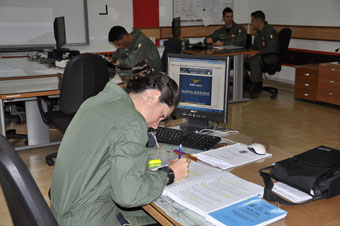


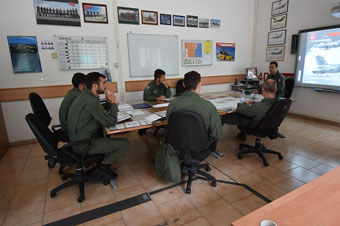
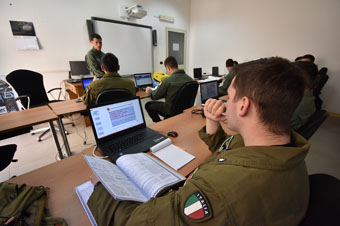






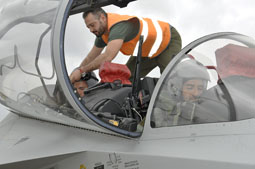
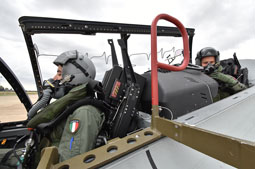












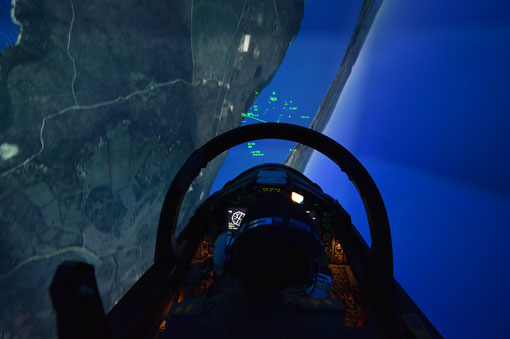

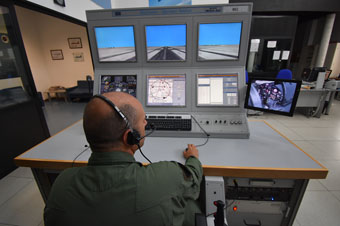

 Tra la fine del 1945 e l’inizio del 1946, il 2° Gruppo Volo della Scuola di Pilotaggio, con la dipendente 3ª Squadriglia, dotata di CR.42, viene trasferito da Lecce sull’aeroporto di Brindisi per svolgere il cosiddetto 2° Periodo di volo, poco dopo il Reparto assume la nuova denominazione di 212° Gruppo Volo e gli vengono assegnate la 402ª e la 403ª Squadriglia.
Tra la fine del 1945 e l’inizio del 1946, il 2° Gruppo Volo della Scuola di Pilotaggio, con la dipendente 3ª Squadriglia, dotata di CR.42, viene trasferito da Lecce sull’aeroporto di Brindisi per svolgere il cosiddetto 2° Periodo di volo, poco dopo il Reparto assume la nuova denominazione di 212° Gruppo Volo e gli vengono assegnate la 402ª e la 403ª Squadriglia.





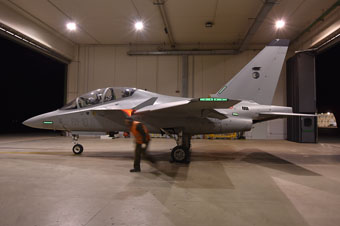
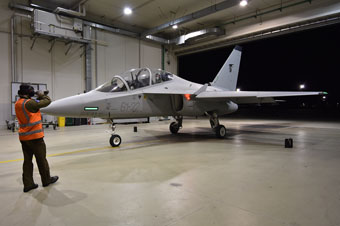

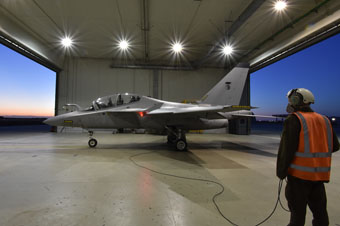


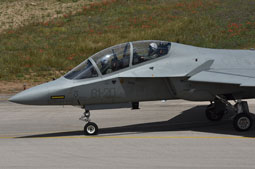

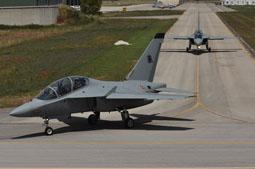
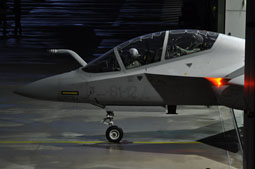

 La storia del 213° Gruppo è legata agli eventi post armistizio dell’8 settembre 1943. Esso trae le sue origini dal 3° Gruppo, costituito il 30 novembre del 1945, successivamente al trasferimento della Scuola di Pilotaggio di Leverano a Lecce (1° Novembre 1945).
La storia del 213° Gruppo è legata agli eventi post armistizio dell’8 settembre 1943. Esso trae le sue origini dal 3° Gruppo, costituito il 30 novembre del 1945, successivamente al trasferimento della Scuola di Pilotaggio di Leverano a Lecce (1° Novembre 1945).













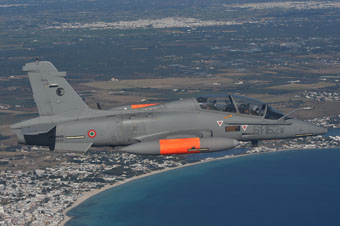

 Il 214° Gruppo Aviogetti è stato costituito presso la Scuola di Volo di Lecce il 1° gennaio del 1962, contestualmente gli vengono assegnate la 424ª e la 425ª Squadriglia, il Reparto vanta il primato di essere stato il primo Gruppo in seno alla Scuola a ricevere il nuovo addestratore Aermacchi MB 326.
Il 214° Gruppo Aviogetti è stato costituito presso la Scuola di Volo di Lecce il 1° gennaio del 1962, contestualmente gli vengono assegnate la 424ª e la 425ª Squadriglia, il Reparto vanta il primato di essere stato il primo Gruppo in seno alla Scuola a ricevere il nuovo addestratore Aermacchi MB 326.




